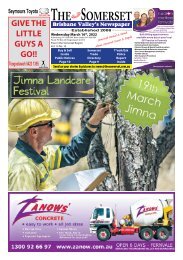Create successful ePaper yourself
Turn your PDF publications into a flip-book with our unique Google optimized e-Paper software.
HORSE<br />
HEY! WANNA KNOW MORE ABOUT HAY?<br />
<strong>The</strong>re are so many different types of hay and<br />
it can get confusing when you start to try<br />
figuring out which hay to use and why. Or<br />
which hay to avoid and why. Here is my hay<br />
by hay take on… hay:<br />
to feed just before you ride or work horses to<br />
fill their stomach up and protect it from ulcers<br />
too. Plus it is rich in essential amino acids so<br />
it will help support the guts needs for the<br />
amino acids it needs to stay healthy!<br />
cereal hay it will feed the bad bacteria in the<br />
hindgut and may cause some discomfort<br />
from excess gas production.<br />
LUCERNE HAY<br />
PROS<br />
Horses love lucerne so you rarely ever get<br />
‘meals sent back to the kitchen’. Lucerne<br />
is also super nutritious; it contains lots of<br />
minerals (especially calcium), is rich in fibre<br />
and high in quality protein.<br />
Lucerne hay is LOW in starch and water<br />
soluble carbohydrates (collectively known<br />
as the non-structural carbohydrates or NSC).<br />
Which means lucerne hay is SAFE for laminitic<br />
horses and ponies.<br />
It is also high in calories, which makes it the<br />
perfect hay for horses needing to gain weight<br />
and build muscle.<br />
I love lucerne as part of almost every horse’s<br />
diet. It adds great nutrition and it brings the<br />
aspect of variety in the form of a legume<br />
forage to the diet.<br />
CONS<br />
It is a high calorie hay so for horses who are<br />
overweight it can be an issue. You need to<br />
feed it in very restricted amounts as it is easy<br />
to make horses too fat on too much lucerne.<br />
Lucerne’s high protein levels mean you can<br />
feed too much protein if you feed too much<br />
lucerne. For most horses this isn’t an issue. But<br />
for horses in stables it means their boxes will<br />
be wet and smelly (as they need to drink a lot<br />
and urinate more to rid the excess nitrogen<br />
from the protein out of their body). This<br />
excessive urination can also lead electrolyte<br />
depletion and in extreme cases, tying up in<br />
working horses. It is important to remember<br />
though that it is not the lucerne causing this<br />
as such. It is the excess protein. So if you feed<br />
appropriate amounts of lucerne, you won’t<br />
see these issues.<br />
Its high calcium characteristic also needs to<br />
be managed carefully, especially for growing<br />
horses. Diets that contain only lucerne<br />
for youngsters will often have a calcium:<br />
phosphorus ratio that is too high, which can<br />
then cause phosphorus deficiency and may<br />
affect correct bone development.<br />
Lucerne for gut health: A big thumbs up!<br />
Studies show lucerne helps gastric ulcers<br />
heal. It is a natural buffer so it is a great forage<br />
CEREAL HAY (OATEN, WHEATEN,<br />
BARLEY)<br />
PROS<br />
When made-well, horses usually love cereal<br />
hay. Being ‘grasses’, cereal hay is lower in<br />
protein so it can be used as the base forage<br />
in a horse’s diet without providing too much<br />
protein.<br />
Cereal hay contains lots of great fibre.<br />
Depending on its stage of harvest and its<br />
starch and water-soluble carbohydrate<br />
content, cereal hay may be anything from a<br />
high calorie to a very low-calorie hay… if you<br />
have the luxury of choice and are using cereal<br />
hay, you can select which is best for your<br />
horses.<br />
CONS<br />
Cereals are temperate grasses. So they has<br />
the ability to store LARGE amounts of starch<br />
and water soluble carbohydrates (WSC),<br />
including fructans. I have seen oat forage<br />
with 30% plus starch+ WSC (collectively<br />
called non-structural carbohydrate, or NSC);<br />
which means cereal hay must be avoided for<br />
any horses that need a low NSC diet.<br />
Cereal hays with a high fructan content can<br />
also cause a shift in hindgut bacteria toward<br />
the ‘bad’ bacteria. Fructan is one of their<br />
favourite meals. When horses are on a high<br />
fructan cereal hay, you might see some of the<br />
behavioural changes and some loss of fibre<br />
fermentation (with possible issues holding<br />
weight) that we see in horses on ‘uncooked<br />
grain’ diets. Plus fermentation in the hindgut<br />
of a high fructan cereal hay can cause<br />
excessive gassiness and mild colic.<br />
Not all cereal hay is high in fructan, but my<br />
advice would be if you are going to buy cereal<br />
hay in large amounts, get it tested before you<br />
purchase it.<br />
Cereal Hay for Gut Health: It is a bit of a lucky<br />
dip. If you manage to get a low fructan cereal<br />
hay then it is great for gut health. It provides<br />
lots of fibre to keep the good bacteria in the<br />
hindgut healthy and it is a hay that requires a<br />
lot of chewing so it’s great to stimulate saliva<br />
production.<br />
On the downside, if you do get a high fructan<br />
RHODES GRASS HAY<br />
PROS<br />
This is one of my favourite hays, for many<br />
reasons… Rhodes grass is a subtropical grass<br />
which means it can’t store large amounts of<br />
starch or water soluble carbohydrates (WSC).<br />
Rhodes grass will usually have a starch +<br />
WSC content (known together as the nonstructural<br />
carbohydrates, or NSC) of less than<br />
<strong>12</strong>%, making it consistently safe to feed to<br />
horses that need a low NSC diet. Including<br />
laminitic horses and ponies.<br />
Rhodes grass hay is usually a moderate<br />
protein, moderate calorie hay (depending on<br />
its stage of growth when it was harvested)<br />
so it lends itself well to being the base hay in<br />
almost any horse’s diet.<br />
Horses don’t love Rhodes grass hay, so they<br />
will often take their time in eating it. If you<br />
have easy keepers on restricted hay diets, this<br />
is a good thing. It extends the amount of time<br />
they are chewing and salivating which should<br />
then reduce the risk of stomach ulcers.<br />
CONS<br />
For horses that are a bit fussy, Rhodes grass<br />
hay may be somewhat of a frustration. Other<br />
than that, there are really no downsides to<br />
this hay. It can make a valuable addition to<br />
any balanced diet.<br />
Rhodes Grass Hay for Gut Health: Rhodes<br />
Grass Hay comes in with flying colours on<br />
the gut health front. Lots of fibre to provide<br />
food for our favourite friendly bacteria. Plus<br />
it is consistently low in starch and fructans so<br />
it won’t support the bad bacteria in any way.<br />
TROPICAL GRASS HAY (INCL.<br />
HUMIDICOLA, PANGOLA, JARRA,<br />
PANIC GRASSES)<br />
Grass species commonly found in Northern<br />
Australia.<br />
PROS<br />
Tropical grasses tend not to accumulate<br />
large amounts of NSC (especially fructans)<br />
compared with temperate grasses, generally<br />
making them safer for laminitis-prone horse.<br />
Tropical grass hay is usually a low protein,<br />
moderate calorie hay (depending on its stage<br />
of growth when it was harvested) but it lends<br />
TALK<br />
itself well to being the base hay in almost<br />
any horse’s diet – especially in hot humid<br />
environments where the amount of protein<br />
in diets is best kept not in excess.<br />
CONS<br />
<strong>The</strong>se grasses contain a moderate amount<br />
of oxalate and have been observed to cause<br />
suspected ‘bighead’. When feeding them,<br />
careful supplementation with calcium is<br />
required.<br />
Tropical Grass Hay for Gut Health: No<br />
negatives. Good levels of fibre to keep the<br />
hindgut healthy and generally lower in<br />
fructans so it won’t upset the healthy balance<br />
of microbes.<br />
NATIVE GRASS HAY<br />
True native grass hays are very rare – mostly<br />
found in Northern Australia. Some native<br />
grass species that can be found as hay<br />
can be Creeping Bluegrass, Red Grass and<br />
Queensland Bluegrass.<br />
More often than not, hay is labelled ‘Native’<br />
when it is from unimproved pastures and<br />
many of the grasses these contain are likely<br />
to be low fertility introduced grasses such<br />
as; Southern Australia & New Zealand -<br />
sweet vernal, fog grass, brown-top, bromes<br />
or prairie grass or Northern Australia – digit<br />
grasses and panic grasses.<br />
PROS<br />
A true native grass hay is likely to be low<br />
in NSC, a great source of fibre plus lower in<br />
protein and calories than introduced grass<br />
species.<br />
CONS<br />
Hard to source. Some fussier horses may find<br />
native grass hays less palatable.<br />
Native Grass Hay for Gut Health: No negatives.<br />
Good levels of fibre to keep the hindgut<br />
healthy and generally lower in fructans so it<br />
won’t upset the healthy balance of microbes.<br />
Until next time horsey people.<br />
I hope you are having a happy horsey New<br />
Year.<br />
<strong>The</strong> Barn Cat<br />
Silas Strachan<br />
Qualified Master Farrier (Cert. IV Farriery - University of Qld) / Horse Trainer<br />
Call: 0423 66 33 02<br />
• HOT/COLD SHOEING • TRIMMING<br />
• HORSE STARTING • TRAINING<br />
Advertise in <strong>The</strong> <strong>Lockyer</strong> NOW - Call 0411 896 004<br />
THE LOCKYER - Wednesday <strong>January</strong> <strong>12</strong>, <strong>2022</strong> - <strong>Page</strong> 7

















